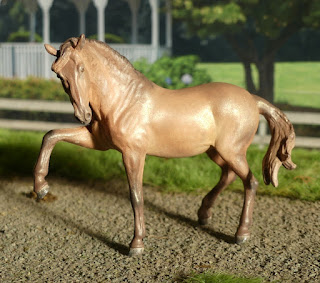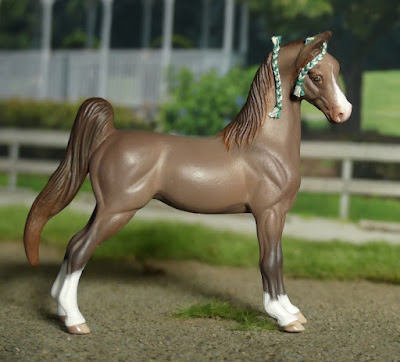A recent discussion with some Julip fans about what colours we'd got, and especially what colours were missing from our collections, made me wonder the same for the colours I'd painted. After last year's shock realisation that I'd never done red dun or cremello customs, were there other obvious gaps I really should have filled by now? So I dug the colours chart back out, and started ticking off the ones I've already painted at least once.
What's left stands out as a Never Painted list of colours I'd somehow never thought of, or avoided because I preferred other variations on the same theme, and this year I'm determined to fill some of those gaps.
The list contains four kinds of appaloosa, because surprisingly in all this time I've only ever painted blanket spotted, leopard or semi-leopard, or a sort of extended blanket varnish roan combination of spots on top of mottled colour. I decided to tackle snowflake first from my missing ones, a pretty colour which I'd deliberately never tried cos I feared it'd look too much like white paint spattered over a perfectly good paintjob!
So instead of risking the paint-spatter technique, I decided to go with a much more controlled application of white, got out one of my tiniest brushes, and applied the spots and roaning carefully by hand. It took ages, but I think the results are worth it!

The rather unexpected mould choice is because last year I found a photo in a 1970s horse book featuring a very incongruous looking snowflake appaloosa in an everyday Irish high-street horse market. He stood out so much I took a
picture of the page for my 'horse colour ref' folder, and although I didn't go quite so heavily on the spotting for my model version, I wanted to paint one which could be an eye-catching Irish hunter, rather than an American stock horse type.
I might do another at some point, more heavily spotted or with larger snowflakes, but he just seemed to reach the point where he looked good enough, so I stopped here rather than risking spoiling him - I like this ratio of colour to white! I've named him Orion's Bow, a nod to his huntery inspiration, and his snowflakes could be taken as a lot of twinkling stars.
Of course, as usual when researching a colour, I was then in the middle of an appaloosa mood, and the very next custom ticked off another of the missing patterns - snowcap appaloosa, a blanket without the usual spots inside it. It's not that I don't like this colour on real horses, I just enjoy painting the spots on model ones, so I'd never done the appaloosa types which don't have any spotting!
As I've said before, I'm not the biggest fan of the reiner mould as such, but when it's in a really interesting colour my opinion flips and I love them, so I decided to put this good pattern on the final one in my body box, and it seems to suit him so well! The pink-speckled skin round the eyes and muzzle brings his face to life, and I had fun adding all the rough uneven roaning over the basic bay base colour.
Here's that blanket without spots - the temptation to add some was so strong cos I knew he'd look even more detailed and interesting with them than without, but then I wouldn't be ticking off that long-avoided snowcap after all, and would have to use up another body to get round to it!


A couple more angles, just because he's not quite the same on both sides, and the light helps bring out the detailing of his face. I've named him Snow Angel, to suit both the name of his colour, and the time of year (we had snow in December, my horse makes snow angels by rolling in multiple spots all over the field).
Another notable gap in my herd of customs was Pearl. A relatively recently identified dilution gene, which only really came to light many years after I'd already learnt about horse colours and started painting them, so I suppose I didn't see it as 'missing' cos it never was in my mind to start with!
Most famous in Iberian breeds, I dithered between using up one of the G2 Andalusians which've been in my body box for ages, or picking the much newer Spanish Walk Andalusian, in the end the more exciting choice won!
Pearl is one of those colours which looks made up - ten or fifteen years ago, this would've been written off as fictional pretty-horse painting, or at best a badly done dun by someone who didn't understand, or forgot, the dark points. The pearl dilution works by altering base colours, but it's more complicated than usual. One pearl gene, and the horse's colour isn't changed, it'll just look bay or chestnut or whatever. Two pearl genes, and you get the pearl colouration. But here's the thing - cream can also work as a 'second' pearl gene, so a horse carrying one cream gene and one pearl, will come out with paler variations of the pearl colour.
I went for one of the more basic options, bay plus two pearl genes, creating a colour known as brown pearl, and have named him Valenciano.
Here he is in different light, his dapples hide but his face looks nicer, I think! Double pearl horses have amber eyes and pale grey-brown skin visible on the muzzle and round the eyes, while pearl plus cream will show paler hazel-green or blue eyes, and their skin is much pinker.
This mould looks nice in hand, but is very frustrating to photograph anything but directly side-on, because the head is always either at an unappealing angle, or out of focus! I also spotted a bit of stray brown moss in the background, behind his raised hoof here, which looks like a little pile of horse poo in the other shots. Accidental realism!
The final one of this little batch of missing colours, and it's another unusual one to tick off.
Champagne, like pearl, is a gene which works over the top of other colours. A black horse with the champagne gene becomes classic champagne, bay becomes amber champagne, and chestnut becomes gold champagne (but it can also overlap other genes like cream or dun or silver, leaving multitudes of possible combinations!). I'd done an amber champagne pinto before, but none of the others, so classic champagne was top of the to-do list.
The classic champagne colour is a lovely lustrous brown, with darker points, and these ginger tips to the mane and tail in all the reference photos I collected before I started to paint. Like all champagnes, they also have distinctive mottled skin, peach with dark speckles rather than the pink-on-black seen in appaloosas, and pale hazel greenish eyes. The colour has the potential to look quite muddy and plain when painted, but the darker points do give it depth, the unusual colour skin and eye detailing add interest, and I gave mine some flashy white markings to stand out nicely, too, so I'm really pleased with how she looks.
The sun came out a little brighter between shots, and this photo makes her look much paler and with a warmer tone - it's interesting how some real life horses look such different shades in bright sun or a dull day, and I found it curious that this model version does the same.


Some different angles - this mould seems to 'pose' so nicely for the camera! Her mane braids are done with my usual technique of carving away the original oddly sausagey plastic ones and attaching plaited thread instead - by gluing the lower ends down as well you can be sure they lay just right to cover any rough marks left by removing the moulded-on braids.
That's it for now, I'm satisfied with four colours ticked off the Never Painted list, four nice new little customs for my shelves, and while there's still a few colours and patterns I definitely want to do in future (varnish/marble appaloosa and medicine hat pinto are now top of the to-do list!), I don't have any urge to complete the whole thing. There's loads of obscure modifier-gene combinations out there, so I'm not even going to consider ticking off every last one of the entire set of possibilities, I'll just be happy to have filled some gaps I didn't realise I had.













No comments:
Post a Comment